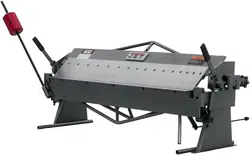Loading ...
Loading ...
Loading ...

6
6.0 Adjustments
6.1 Counterweight position
Proper counterweight position determines amount
of leverage for the bend, and most efficient
movement of apron for the operator.
To adjust counterweight, back out screw (A
1
, Figure
2) and slide counterweight to desired position.
Retighten screw.
6.2 Apron and finger alignments
The apron assembly has been adjusted by the
manufacturer for use with material having the
capacity listed in the Specifications section. If any
misalignment occurs, correct as follows.
The forward edge of hold-down fingers (F, Figure 4)
should be adjusted parallel to pivot edge of
clamping table. Release clamping pressure on hold-
down assembly by pushing clamp handles (G)
slightly to the rear. Turn hand knobs (H) to adjust
hold-down assembly for parallel.
Figure 4
The truss nuts (J, Figure 5) can be used to help
achieve alignment in apron and hold-down
assemblies, by eliminating any bowing at the center
of these assembles.
Finger alignment can be achieved by loosening all
cap screws (F, Figure 5) and raising apron to 90-
degree position. Push fingers forward against apron
bar for alignment. Retighten all screws.
Figure 5
7.0 Operation
7.1 Adjusting for metal thickness
The hold-down assembly must be adjusted to allow
for clearance when making bends according to
material thickness. Clearance for material within
four gauges of the capacity should be twice the
thickness of the material. For lighter gauges use 1-
1/2 times the thickness.
Turn both knobs (H, Figure 4) the same amount to
maintain parallelism of fingers with apron.
7.2 Adjusting clamping pressure
Clamping pressure should be adjusted according to
material thickness. Clamping pressure should be
great enough to hold material securely in place but
not so much that it is difficult to lock the clamping
handles (G, Figure 4). Clamping pressure can be
adjusted by turning the nuts on threaded rod portion
of yoke assembly (K, Figure 4).
7.3 Repeat bends
Adjust stop collar on stop rod (Figure 3) to limit
apron swing.
8.0 User-maintenance
8.1 Lubrication
The machine must be lubricated every day of
service with a few drops of oil at the pivot points. Oil
pinholes are located at both yoke assemblies (A,
Figure 6) and the apron assembly near the hinge pin
(B).
Lightly oil all machined (unpainted) parts when not
in use, to inhibit rust.
Figure 6
Loading ...
Loading ...
Loading ...
